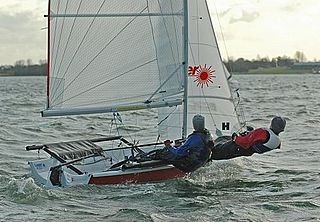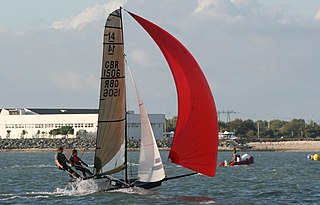Related Research Articles

Dinghy sailing is the activity of sailing small boats by using five essential controls:

The 470 (Four-Seventy) is a double-handed monohull planing dinghy with a centreboard, Bermuda rig, and centre sheeting. Equipped with a spinnaker, trapeze and a large sail-area-to-weight ratio, it is designed to plane easily, and good teamwork is necessary to sail it well. The name comes from the boat's length of 470 centimetres.

The 49er and 49er FX is a two-handed skiff-type high-performance sailing dinghy. The two crew work on different roles with the helm making many tactical decisions, as well as steering, and the crew doing most of the sail control. Both of the crew are equipped with their own trapeze and sailing is done while cantilevered over the water to the fullest extent to balance against the sails.

The International 420 Dinghy is a sailing dinghy popular for racing and teaching. The hull is fiberglass with internal buoyancy tanks. The 420 has a bermuda rig and an optional spinnaker and trapeze. It has a large sail-area-to-weight ratio, and is designed to plane easily. It can be rigged to be sailed single-handed or double-handed. The 420 is an International class recognized by the International Sailing Federation. The name refers to the boat's length of 420 centimetres.

The Musto Skiff is a single-handed sailing skiff with a length of 4.55 m. It features a trapeze, asymmetrical spinnaker, wings and low weight and achieves speeds of over 20 knots, which makes it one of the fastest single-handed sailing boats.

The Hobie Cat is a small sailing catamaran manufactured by the Hobie Cat Company. Hobie's line of products includes surfboards, sailboats, kayaks, stand-up paddle boards, and pedalboards, although the Hobie Cat Company is known worldwide for its catamarans. Hobie also designed a successful monohull, the Hobie 33.

The Laser 2 Regatta is a double-handed version of the popular Laser one-design class of small sailing dinghy. It is a quick, planing dinghy that differs from the Laser in that it has a jib, symmetric spinnaker and a single trapeze for the crew. It was designed by New Zealander Frank Bethwaite and was first launched as a product in Australia then North America in 1979 and in Europe in 1980. The hull is made of GRP. The rig is a Bermudian rig sloop with spinnaker. It is designed to be a mid to high performance racer. In Britain, its most common current use is at university class in British University Sailing Association (BUSA) events. A version known as the Laser Fun was available, the same hull but featuring a reefable mainsail and a roller furling jib, and with the option of an asymmetric spinnaker. As a strict one-design boat the Laser 2 was not available for amateur construction. The class was recognised by World Sailing from early 1980s to 2020 and used as equipment for the Class World Championships and World Sailing own Youth Sailing World Championships. The class had extensive use in Europe and North America as a school and college boat and used for team racing without the spinnaker and trapeze. With more than 10500 boats built production was discontinued in 2007 following merger of Performance Sailcraft Europe and Vanguard Sailboats into a combined entity Laser Performance.

The Fireball is a British sailing dinghy that was designed by Peter Milne as a one-design racer and first built in 1962.

The Laser 4000 is a racing dinghy designed by Phil Morrison crewed by two persons. Its one-design weight-equalised system enables physically differing sailors to compete on a level playing field. It is most popular in Europe, particularly the UK, France and Italy.

The International 14 is a 14-foot double-handed racing dinghy. The class originated in England in the early part of the 20th century. It is sailed and raced in many countries around the world and was one of the first true international racing dinghy classes recognised by International Sailing Federation. It is a development class, being controlled by a set of rules that allow for innovation and changes in hull and rig design as long as they fall within a set of specific limitations such as length, weight, beam, and sail area. The class has permitted its rules to be revised at various times in its history in order to keep the class at the forefront of dinghy racing development and can now best be described as an ultralight dual-trapeze sailing dinghy with large sail area. It is often raced with boats of similar design in one-design, or non-handicap races.

The Cherub is a 12 feet long, high performance, two-person, planing dinghy first designed in 1951 in New Zealand by John Spencer. The class is a development class, allowing for significant variation in design between different boats within the rule framework. The minimum hull weight was originally 110 lbs.

The RS800 is a light-weight sailing dinghy designed by Phil Morrison and manufactured by RS Sailing. The boat is sailed by two people both on trapeze and has a main, jib and spinnaker. The RS800 has a Portsmouth Yardstick number of 820 and a D-PN of 77.0. There is a large racing circuit in the UK, and some European events each year.

The International Canoe (IC) is a powerful and extremely fast single-handed sailing canoe whose rules are governed by the International Canoe Federation.

The Laser 3000 is a racing sailing dinghy crewed by two persons with a trapeze for the crew. Launched in 1996, the 3000 was developed from the Laser 2, using the original Frank Bethwaite-designed planing hull combined with a brand new self-draining deck by Derek Clark. Clark also re-designed the rig, using spars and sails from premium proprietary sources and replacing the symmetric spinnaker of the Laser 2 by a larger asymmetrical spinnaker. The gennaker is chute-launched and retrieved using a single halyard line, and is set on a retractable bowsprit. Helm balance and handling were improved using a shorter-footed mainsail with two full-width battens giving a larger roach. A mast with conventional spreaders replaced the now-unusual diamond arrangement of the Laser 2.

The 3000 is a racing sailing dinghy crewed by two persons with a trapeze for the crew. Launched in 1996 as the Laser 3000, the 3000 was developed from the Laser 2, using the original Frank Bethwaite-designed planing hull combined with a new designed self-draining deck by Derek Clark. Clark also re-designed the rig, using spars and sails from premium proprietary sources and replacing the symmetric spinnaker of the Laser 2 by a larger asymmetric spinnaker (gennaker). The gennaker is chute-launched and retrieved using a single halyard line, and is set on a retractable bowsprit. Helm balance and handling were improved using a shorter-footed mainsail with two full-width battens giving a larger roach. A mast with conventional spreaders replaced the now-unusual diamond arrangement of the Laser 2.

The RS400 is a light-weight sailing dinghy designed by Phil Morrison and manufactured by RS Sailing. The dinghy is sailed by two people and has a main, a jib and an asymmetric spinnaker. It has a PY of 948 and a D-PN of 82.3.

The Laser Vago is a British/American sailing dinghy that was designed by Jo Richards as a one-design racer and first built in 2005.
The RS700 is a single-handed racing dinghy built by RS Sailing and designed in 2000 by Nick Peters and Alex Southon as part of the RS series and built in 2001. It is raced in many sailing clubs around Britain, with a PY number of 850 and a D-PN of 73.3.

The Buzz is a sailing dinghy designed in 1994 by Ian Howlett and John Caig and manufactured by Reg White Limited of Brightlingsea as part of the "White Formula" range of boats originally marketed by Topper International Ltd but since 2013 by Vantage Sailing. The Buzz is a double handed racing boat, with a single trapeze for the crewman. The boat has a fully battened mainsail, furling jib and an asymmetrical spinnaker. There have been around 500 boats built. The Buzz is designed to be an easy to sail boat, but it can also be raced competitively.
The B14 is a two man monohull dinghy, designed by Julian Bethwaite. It is recognised as an international class by the International Sailing Federation. The boat was designed in 1984.
References
- ↑ "RYA Portsmouth Number List 2017" (PDF). Royal Yachting Association. Archived from the original (PDF) on 30 June 2017. Retrieved 18 July 2017.
- ↑ "Home". isoracing.org. Retrieved 2017-04-27.
- ↑ "Vantage Sailing Ltd". vantagesailing.com. Retrieved 2017-07-25.
- ↑ "ISO Dinghy Class Rules". isoracing.org. ISO Class Association. Retrieved 2017-07-25.
- ↑ "RYA Affiliation". isoracing.org. ISO Class Association. Retrieved 2017-04-27.